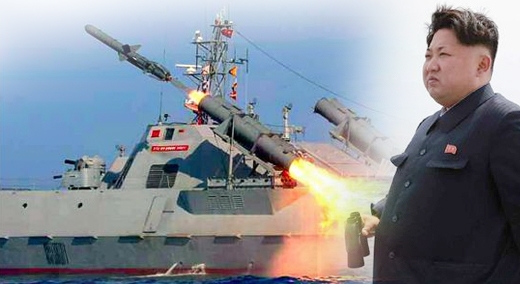North Korea launches long-range missile

Defying multiple international warnings, North Korea launched a long-range ballistic missile Sunday morning, according to the South’s Ministry of National Defense.
North Korea fired a rocket at around 9:30 a.m. from its Tongchang-ri launch site in Cholsan County, North Pyongan Province, according to military officials here. The missile flew in a southern direction from North Korea’s west coast, over the Yellow Sea.
The North’s official Korean Central Television in a special announcement three hours later declared that the regime had successfully launched into orbit its Kwangmyongsong-4 Earth observation satellite at 9:09 a.m., Pyongyang time. This was seen by the international community as a cover for a ballistic missile test.
The broadcast added that North Korean leader Kim Jong-un ordered the launch of the Kwangmyongsong-4 on Saturday. This launch took place the following day at 9:00 a.m. at a satellite launching station in Cholsan.
Pyongyang last year set its own time zone which is 30 minutes behind Seoul.
North Korea’s announced time frame and location are in accordance to the information detected by South Korea’s radar systems, including one aboard its Aegis destroyer.
The South’s radar-equipped Sejong the Great Aegis destroyer detected the launch at 9:31 a.m., according the Defense Ministry, and the rocket's first stage detached over the Yellow Sea at 9:32 a.m. The fairing fell off four minutes later, and at this point the rocket disappeared from the detection of South Korean surveillance radars at 9:36 a.m. southwest of Jeju Island.
There were no reported damages.
South Korea’s military also concluded that a projectile seems to have entered into orbit, and defense officials and analysts see Pyongyang’s launch as being successful.
North Korea’s long-range missile is thought by analysts to have a range of 13,000 kilometers, which could potentially reach mainland United States.
South Korean military officials see that Pyongyang’s long-range rocket capabilities have developed from the three-stage rocket, Unha-3. North Korea launched the Unha-3 in December 2012, and the regime declared it had successfully put what it claimed to be a satellite into orbit.
President Park Geun-hye immediately convened an emergency meeting of the National Security Council to discuss how to respond to North Korea’s missile test, which she called “an act of defiance.”
“North Korea from the beginning of the new year ignored warnings by the international community by conducting its fourth nuclear test, and has again launched a long-range missile, another provocation that cannot be allowed,” Park said at the meeting.
She added, “This missile launch--which comes at a time when the UN Security Council is discussing a resolution on its nuclear test--is an act of defiance against the international community that hopes for peace.”
Foreign Minister Yun Byung-se, Defense Minister Han Min-koo, Unification Minister Hong Yong-pyo and National Intelligence Service chief Lee Byung-ho took part in the meeting at the Blue House.
Under United Nations Security Council resolutions, North Korea is banned from testing or acquiring nuclear or ballistic missile technology.
Pyongyang initially notified international organizations on Tuesday that it plans to launch what it called an Earth observation satellite between Feb. 8 and Feb. 25 sometime between 7 a.m. and noon Pyongyang time, which is 30 minutes ahead of Seoul.
But on Saturday, North Korea informed United Nations agencies including the International Maritime Organization (IMO) that it will move up its expected launch window to between Feb. 7 and Feb. 10.
Seoul officials saw the move to reflect the good weather during that time frame.
The South Korean government “strongly condemns” the long-range missile launch, said Cho Tae-yong, the deputy chief of the National Security Office.
He added that the government will “not only put all efforts into drawing strong sanctions from the UN Security Council but will continue to put necessary pressure to make sure North Korea changes itself.”
One month ago, Pyongyang conducted its fourth nuclear test on Jan. 6, which it claimed was a successful hydrogen bomb. This has led for a push for harsher sanctions by the UN Security Council.
Defense Minister Han Min-koo likewise called the missile launch a “frontal challenge to international society and a challenge and threat to the Korean Peninsula and to the peace and stability in the region.”
Han convened on Sunday a South Korea-U.S. emergency meeting at the Defense Ministry in Seoul, also attended by Gen. Curtis Scaparrotti, commander of the U.S. Forces Korea, and U.S. Ambassador Mark Lippert.
“We need to make North Korea realize that unless it gives up its nuclear program, it will not be able to survive,” Han said, as he called for close cooperation between the South Korea and U.S. alliance.
South Korea, along with the United States and Japan, requested Sunday for an emergency meeting of the UN Security Council following Pyongyang’s missile launch. According to the South Korean Ministry of Foreign Affairs, a UN Security Council meeting will convene in New York on Sunday.
The international community also condemned Pyongyang’s latest act of provocation.
U.S. National Security Advisor Susan Rice in a statement said, "North Korea's launch using ballistic missile technology, following so closely after its Jan. 6 nuclear test, represents yet another destabilizing and provocative action.” She called it a “flagrant violation” of UN Security Council resolutions.
Japanese Prime Minister Shinzo Abe also immediately condemned the launch speaking to reporters at his residence in Tokyo, saying it “cannot be allowed.”
China’s state-run Xinhua News Agency urged “restraint” from all relevant parties, calling the rocket launch “a negative development” on the Korean Peninsula. However, it said that “sanctions are definitely not the aim.”
BY SARAH KIM [kim.sarah@joongang.co.kr]










with the Korea JoongAng Daily
To write comments, please log in to one of the accounts.
Standards Board Policy (0/250자)